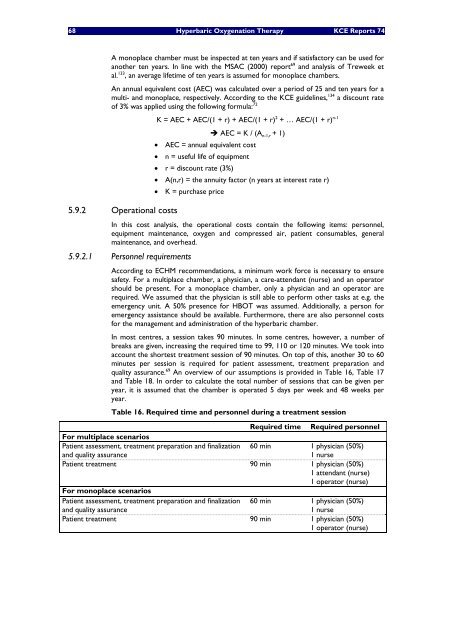Hyperbare Zuurstoftherapie: Rapid Assessment - KCE
Hyperbare Zuurstoftherapie: Rapid Assessment - KCE
Hyperbare Zuurstoftherapie: Rapid Assessment - KCE
You also want an ePaper? Increase the reach of your titles
YUMPU automatically turns print PDFs into web optimized ePapers that Google loves.
68 Hyperbaric Oxygenation Therapy <strong>KCE</strong> Reports 74<br />
A monoplace chamber must be inspected at ten years and if satisfactory can be used for<br />
another ten years. In line with the MSAC (2000) report 69 and analysis of Treweek et<br />
al. 133 , an average lifetime of ten years is assumed for monoplace chambers.<br />
An annual equivalent cost (AEC) was calculated over a period of 25 and ten years for a<br />
multi- and monoplace, respectively. According to the <strong>KCE</strong> guidelines, 134 a discount rate<br />
of 3% was applied using the following formula: 72<br />
5.9.2 Operational costs<br />
K = AEC + AEC/(1 + r) + AEC/(1 + r) 2 + … AEC/(1 + r) n-1<br />
AEC = K / (An-1,r + 1)<br />
• AEC = annual equivalent cost<br />
• n = useful life of equipment<br />
• r = discount rate (3%)<br />
• A(n,r) = the annuity factor (n years at interest rate r)<br />
• K = purchase price<br />
In this cost analysis, the operational costs contain the following items: personnel,<br />
equipment maintenance, oxygen and compressed air, patient consumables, general<br />
maintenance, and overhead.<br />
5.9.2.1 Personnel requirements<br />
According to ECHM recommendations, a minimum work force is necessary to ensure<br />
safety. For a multiplace chamber, a physician, a care-attendant (nurse) and an operator<br />
should be present. For a monoplace chamber, only a physician and an operator are<br />
required. We assumed that the physician is still able to perform other tasks at e.g. the<br />
emergency unit. A 50% presence for HBOT was assumed. Additionally, a person for<br />
emergency assistance should be available. Furthermore, there are also personnel costs<br />
for the management and administration of the hyperbaric chamber.<br />
In most centres, a session takes 90 minutes. In some centres, however, a number of<br />
breaks are given, increasing the required time to 99, 110 or 120 minutes. We took into<br />
account the shortest treatment session of 90 minutes. On top of this, another 30 to 60<br />
minutes per session is required for patient assessment, treatment preparation and<br />
quality assurance. 69 An overview of our assumptions is provided in Table 16, Table 17<br />
and Table 18. In order to calculate the total number of sessions that can be given per<br />
year, it is assumed that the chamber is operated 5 days per week and 48 weeks per<br />
year.<br />
Table 16. Required time and personnel during a treatment session<br />
For multiplace scenarios<br />
Patient assessment, treatment preparation and finalization<br />
and quality assurance<br />
Required time Required personnel<br />
60 min 1 physician (50%)<br />
1 nurse<br />
Patient treatment 90 min 1 physician (50%)<br />
1 attendant (nurse)<br />
1 operator (nurse)<br />
For monoplace scenarios<br />
Patient assessment, treatment preparation and finalization<br />
and quality assurance<br />
60 min 1 physician (50%)<br />
1 nurse<br />
Patient treatment 90 min 1 physician (50%)<br />
1 operator (nurse)

















